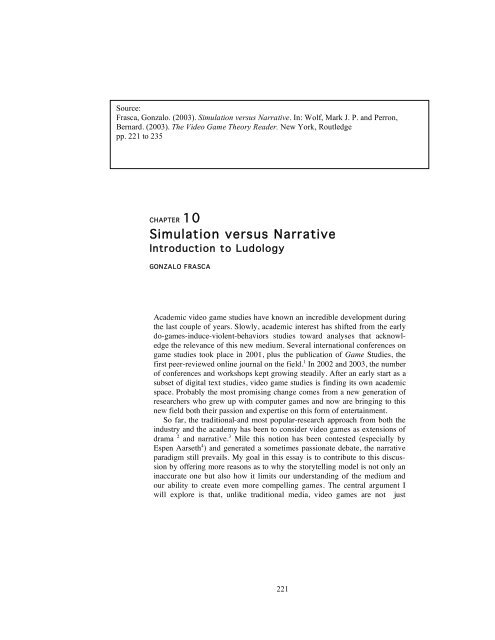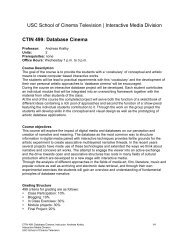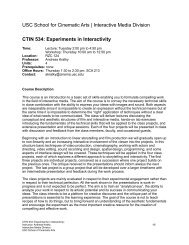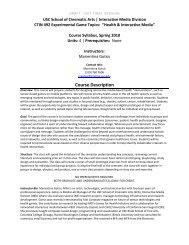Simulation versus Narrative - USC Interactive Media Division
Simulation versus Narrative - USC Interactive Media Division
Simulation versus Narrative - USC Interactive Media Division
- No tags were found...
Create successful ePaper yourself
Turn your PDF publications into a flip-book with our unique Google optimized e-Paper software.
Source:Frasca, Gonzalo. (2003). <strong>Simulation</strong> <strong>versus</strong> <strong>Narrative</strong>. In: Wolf, Mark J. P. and Perron,Bernard. (2003). The Video Game Theory Reader. New York, Routledgepp. 221 to 235CHAPTER 10<strong>Simulation</strong> <strong>versus</strong> <strong>Narrative</strong>Introduction to LudologyGON ZALO FRASCAAcademic video game studies have known an incredible development duringthe last couple of years. Slowly, academic interest has shifted from the earlydo-games-induce-violent-behaviors studies toward analyses that acknowledgethe relevance of this new medium. Several international conferences ongame studies took place in 2001, plus the publication of Game Studies, thefirst peer-reviewed online journal on the field. 1 In 2002 and 2003, the numberof conferences and workshops kept growing steadily. After an early start as asubset of digital text studies, video game studies is finding its own academicspace. Probably the most promising change comes from a new generation ofresearchers who grew up with computer games and now are bringing to thisnew field both their passion and expertise on this form of entertainment.So far, the traditional-and most popular-research approach from both theindustry and the academy has been to consider video games as extensions ofdrama 2 and narrative. 3 Mile this notion has been contested (especially byEspen Aarseth 4 ) and generated a sometimes passionate debate, the narrativeparadigm still prevails. My goal in this essay is to contribute to this discussionby offering more reasons as to why the storytelling model is not only aninaccurate one but also how it limits our understanding of the medium andour ability to create even more compelling games. The central argument Iwill explore is that, unlike traditional media, video games are not just221
true with a particular form of structuring representation: narrative. Someauthors, such as Mark Turner, 7 even state that narrative mechanisms arecognitive structures deeply hard-wired into the human mind. It is because ofits omnipresence that it is usually difficult to accept that there is analternative to representation and narrative: simulation.<strong>Simulation</strong> is not a new tool. It has always been present through suchcommon things as toys and games but also through scientific models orcybertexts like the I-Ching. However, the potential of simulation has beensomehowlimited because of a technological problem: it is extremely difficultto model complex systems through cogwheels. Naturally, the invention of thecomputer changed this situation.In the late 1990s, Espen Aarseth revolutionized electronic text studieswith the following observation: electronic texts can be better understood ifthey are analyzed as cybernetic systems. He created a typology of texts andshowed that hypertext is just one possible dimension of these systemic texts,which he called "cybertexts." Traditional literary theory and semiotics simplycould not deal with these texts, adventure games, and textual-based multiuserenvironments because these works are not just made of sequences of signsbut, rather, behave like machines or sign-generators. The reign ofrepresentation was academically contested, opening the path for simulationand game studies.Scientists have traditionally used simulation for explanatory purposesand particularly for predicting the behavior of complex systems. Treatisesabound on simulation theory but generally they provide an approach that istoo technical and goal-oriented for our task of understanding it as an alternativeto representation. What follows is a working definition that I distilledfrom combining elements of semiotics with several computer simulationtheory essays. 8 I removed any references to the computer, since simulationcan exist in nonelectronic devices such as traditional toys. This definitionis provisory; it does not aim to be exhaustive and it will certainly changeas we increase our understanding of simulation semiotics or "simitiocs."Therefore: "to simulate is to model a (source) system through a differentsystem which maintains (for somebody) some of the behaviors of theoriginal system. " The key term here is "behavior." <strong>Simulation</strong> does not simplyretain the-generally audiovisual-characteristics of the object but italso includes a model of its behaviors. This model reacts to certain stimuli(input data, pushing buttons, joystick movements), according to a set ofconditions.Traditional media are representational, not simulational. They excel atproducing both descriptions of traits and sequences of events (narrative). Aphotograph of a plane will tell us information about its shape and color, but itwill not fly or crash when manipulated. A flight simulator or a simple toyplane are not only signs, but machines that generate signs according223
to rules that model some of the behaviors of a real plane. A film about a planelanding is a narrative: an observer could interpret it in different ways (i.e.,"it's a normal landing" or "it's an emergency landing"), but she cannotmanipulate it and influence how the plane will land since film sequences arefixed and unalterable. By contrast, the flight simulator allows the player toperform actions that will modify the behavior of the system in a way that issimilar to the behavior of the actual plane. 9 If the player increases the powervariable on the simulator, the simulated plane will move faster through thevirtual sky on the computer screen. As we will later see, video games are justa particular way of structuring simulation, just like narrative is a form ofstructuring representation.To an external observer, the sequence of signs produced by both the film aand the simulation could look exactly the same. This is what many supportersof the narrative paradigm fail to understand: their semiotic sequences mightbe identical, but simulation cannot be understood just through its output. 10This is absolutely evident to anybody who played a game: the feeling ofplaying soccer cannot be compared to the one of watching a match.Apparently, this phenomenological explanation is not as evident as it mayseem. As Markku Eskelinen argues, "Outside academic theory people areusually excellent at making distinctions between narrative, drama, and games.If I throw a ball at you I don't expect you to drop it and wait until it startstelling stories." 11 This problem might be because we are so used to see theworld through narrative lenses that it is hard for us to imagine an alternative.But it may also be true that it is easier to try to apply narratology, which mostresearchers are already familiar with, than starting from scratch from a wholenew approach. Also, because both the public and the media productionindustry are already extremely proficient in consuming and creatingnarratives, the temptation to constrain games to this existing channel may betoo high. Video games imply an enormous paradigm shift for our culturebecause they represent the first complex simulational media for the masses." 12It will probably take several generations for us to fully understand the culturalpotential of simulation, but it is currently encouraged from different fields,such as the constructionist school of education and Boalian drama. One of themost interesting cognitive consequences of simulation is its encouragementfor decentralized thinking, 13 which may in the long-term contest MarkTurner's claim of a "literary mind" by introducing the possibility of analternative "simulational" way of thinking.For several years, I have tried, with mixed success, to expose my nonnarrativetheory of games to both researchers and designers by isolating thestructural formal differences between the two. In this essay, I will propose acomplementary approach based on their rhetoric characteristics. For myargument, I will assume that video games are capable of conveying the ideas224
and feelings of an author. My claim is that simulations can express messagesin ways that narrative simply cannot, and vice versa. Sadly, our currentknowledge of simulation rhetoric is extremely limited but I am confident thatit will develop in the near future. Interestingly, it may not be through thegame industry-that has been quite conservative since the marketing peopletook over the show, encouraging cloning over originality-but, rather, throughadvergames. Advergaming is one of the new buzzwords that are popularamong e-marketers. According to Wired’s Jargon Watch, 14 an advergame is:"A downloadable or Web-based game created solely to enable productplacements." I am not fully satisfied with this definition, since it clearlydenotes the problems of shifting from a representational paradigm to arepresentational one. In my opinion, "product placement" is probably themost straightforward and obvious form of advergaming. Instead, this genre'skey lays in modelin~-not simply representing-the product or a relatedexperience in the form of a toy or game. Many advergames are still satisfiedto show an image of the product or its brand logo within the game instead oftrying to convey experiences that are related to what is being sold. While I ama big supporter of the concept of the video game designer as an auteur, and itis true that many of them do use the medium to express their thoughts, theirmain goal remains to entertain. Advertisers, by contrast, use entertainment asa means but not as an end. What they want is to promote their brands andproducts and, because of this, they see in games a tool for persuasion. Thisputs them in an extremely privileged position for realizing that the potentialof games is not to tell a story but to simulate: to create an environment forexperimentation. An agency can place an ad in a magazine to enumerate theset of gizmos in a new car, but images, sound and text are not enough if theywant their audience to be able to play around with them. In such a case, asimulated environment provides an experience that traditional advertisingcannot deliver. As advergaming grows in popularity, it will hopefully alsospread the idea that games may not just be a form of entertainment. Gamingliteracy will some day make players aware that games are not free ofideological content and certainly advergames will play a role in thiseducation because they have a clear agenda.Game Rhetoric: Freedom of Speech,Freedom of Play?On Friday, April 19, 2002, senior U.S. District Judge Stephen Limbaugh rejecteda request against a St. Louis ordinance passed in 2000 that limited theaccess of minors to video game arcades. 15 According to the Associated Press,Limbaugh reviewed four games and found "no conveyance of ideas,expression, or anything else that could possibly amount to speech. The courtfinds that video games have more in common with board games and sports225
than they do with motion pictures. " One week later, CBS reported that formerwrestler and Minnesota governor Jesse Ventura was considering the useof video games for political propaganda. 16 Obviously, Ventura's campaigncommittee did regard games as a form of speech. Political video gamesare not new-a great example is the popularity of amateur anti-Osamaonline games 17 that were posted after September 11-but until now theyhave almost always relied on parody. If Ventura had gone through with hisproposal, 18 he would have broken into new rhetorical ground, because electoralpropaganda is one of the most visible examples of ideological speech. 19Because of Ventura's status as a pop icon, his games would have probablybeen related to the action genre (he is supposed to be a tough guy, after all).However, political video games would probably shine with more dynamic,exploratory genres such as real-time strategy or simulators. <strong>Simulation</strong> hasbeen used, with different degrees of complexity, to showcase urban dynamics(SimCity) or South-American dictatorships (Trópico). 20 It would not besurprising if in the near future politicians tried to explain their plans on taxor health reform through simulation. As Ted Friedman has pointed out, 21Marx's Capital would make a much better simulator than a film.Even if advergames are likely to be the Petri dish for simulation rhetoric,the example that I will propose is closer to art than to marketing. This isbecause most advocates of the narrativity of games always compare them tonovels, films, or drama. So, I will suggest a topic that has both known successin traditional narrative and is as distant as possible from today's commercialvideo games: a worker's strike. In the late nineteenth century, Emile Zolawrote Germinal, 22 a novel about a strike held by mine workers in the north ofFrance. At the end, the workers are defeated. All their efforts were in vain;their fight was not able to change their miserable work conditions. In the latetwentieth century, Ken Loach described in his film Bread and Roses 23 asimilar story about janitors in Los Angeles. The story ends differently: thejanitors are victorious, even if their leader, an illegal immigrant, is deportedback to Mexico.Traditional storytelling normally deals with endings in a binary way.When Zola wrote Germinal he faced two options: the strikers could win orlose. 24 He opted for the second one, probably for conveying the idea that thesocial revolution was going to be a hard task. By contrast, Loach seems moreoptimistic. He depicts these oppressed janitors who stood up for their rightsand were able to obtain better working conditions, even if their leader failedon a personal level. <strong>Narrative</strong> rhetoric is a well-lubricated tool. As we can seein these two examples, it allows authors to state that even a defeat could meanhope and even victories cannot be attained without losing something. Bothstorytellers are arguing that change is possible. However, neither of them istelling us to what degree that change is possible. We learn that226
workers may fail or win, but diegetic media is not able to break its inherentbinary structure. <strong>Narrative</strong> authors or "narrauthors" only have one shot intheir gun-a fixed sequence of events. 25 At most, they could write five or sixdifferent stories describing strikes, so the reader could make an average anddecide the probabilities that workers have to succeed. But traditionalnarrative media lacks the "feature" of allowing modifications to the stories,even if exceptions happen in oral storytelling and dramatic performances. Insuch media, it is always possible for an audience to go through severaliterations of a story. In a game, going through several sessions is not only apossibility but a requirement of the medium. Games are not isolatedexperiences: we recognize them as games because we know we can alwaysstart over. Certainly, you could play a game only once, but the knowledgeand interpretation of simulations requires repetition.Unlike narrative, simulations are not just made of sequences of events,they also incorporate behavioral rules. Imagine that we designed Strikeman, areal-time strategy game in the tradition of Ensemble Studio's Age of Empiresin which you could play the role of a labor organizer. Your goal would be tohave the most workers join your strike and then deal with its organization andimplementation. Unlike what would happen in storytelling, the sequence ofevents in a simulation is never fixed. You can play it dozens of times andthings would be different. In one session, the boss could call the police andrepress your workers. In another game, you may have to deal with spiesinfiltrated into your organization or another worker may contest yourleadership and try to sabotage your actions. Games always carry a certaindegree of indeterminacy that prevents players from knowing the finaloutcome beforehand. To paraphrase Heraclitus, you never step in the samevideo game twice.Let's focus on two characteristics of such a game. First, the result of thestrike is in part a consequence of your performance as a labor leader. Thismay seem obvious-we like to believe that we are responsible of theconsequences of our actions-but it is not a feature available in storytelling.After all, as we learned from classical Greek drama, stories and fate gotogether. No matter how badly literary theorists remind us of the active roleof the reader, that train will hit Anna Karenina and Oedipus will kill hisfather and sleep with his mother. Similarly, the strike in Germinal is going tobe a failure because the narrauthor decided beforehand that it should be thatway. Nevertheless, simulation authors or "simauthors" can also incorporatedifferent degrees of fate (through hard-coded events, cut-scenes, or bymanipulating pseudorandom events) into their games. Victory is partlybecause of the player's performance but other things are beyond her control.The software could randomly slip in constraints (like an infiltrated saboteur),making your goal more difficult to reach. The simauthor always has the finalword: she will227
e able to decide the frequency and degree of events that are beyond theplayer's control.Second, imagine that we had a library of different simulations dealing withstrikes, designed by different simauthors from different cultures andideologies. Even assuming that all simulations would incorporate a winningscenario, some would be much difficult than others, depending on how theywere programmed. Some might depend more on chance while others woulddefine their outcome based solely on the player's performance. Whoever designsa strike simulator that is extremely hard to play is describing his beliefsregarding social mechanics through the game's rules rather than throughevents. <strong>Simulation</strong>s provide simauthors with a technique that narrauthorslack. They are not only able to state if social change is possible or not, butthey have the chance of expressing how likely they think it may be. This isnot just by stating info (for example, "the probability of winning is 93percent") but, rather, by modeling difficulty. This technique is alsotransparent: it is well hidden inside the model not as a piece of informationbut as a rule. <strong>Narrative</strong> may excel at taking snapshots at particular events butsimulation provides us with a rhetorical tool for understanding the big picture.Aristotle on the HolodeckI previously described stories as being heavily associated with the concept offate. This idea is the backbone behind the Marxist drama school, developedby Bertolt Brecht and more recently expanded by Augusto Boal. Marxistsargue that Aristotelian drama and storytelling neutralize social change becausethey present reality as an inexorable progression of incidents withoutroom for alterations. Boal's answer to this problem can be found in his corpusof drama techniques, the Theater of the Oppressed, 26 which combines theaterwith games in order to encourage critical debate over social, political, andpersonal issues. The forum theater, one of his most popular techniques,reenacts the same play several times by allowing different audience membersto get into the stage and take the protagonist's role. This short play alwaysdepicts an oppressive situation and the audience is encouraged to participateby improvising possible solutions to the problem that is being staged. Boal'sultimate goal is not to find an actual solution to the crisis even if sometimesthe technique actually accomplishes this-but, rather, to create an environmentfor debating not just through verbal communication but also throughperformance. Forum theater perfectly fits the definition of simulation: 27 itmodels a system (the oppressive situation) through another system (theplay). 28Video game designers have searched for decades for a way of bringingtogether the pleasures of stories and "interactivity." As Lev Manovich states,228
"<strong>Interactive</strong> narrative remains a holy grail for new media.” 29 Brenda Laurel,a long-time advocate of interactive stories' feasibility has recently definedthem as "a hypothetical beast in the mythology of computing, an elusiveunicorn we can imagine but have yet to capture,” 30 Nevertheless, Boal wasable to create a non-computer-based environment that combines a highdegree of freedom for participants while creating a compelling experience.However, Boal's success is probably due to the fact that he took a differentpath than the one suggested by Laurel in her now classic Computers asTheater. Laurel, as well as most "interactive narrative" supporters, focuseson Aristotelian closure as the source of the user's pleasure. The biggest fallacyof "interactive narrative" is that it pretends to give freedom to the player whilemaintaining narrative coherence. The pleasure in Boalian drama is given notby its seamless three-act structure but by the opposite: the ability to interruptand modify it. <strong>Simulation</strong>s are laboratories for experimentation where useraction is not only allowed but also required. Coherence from session tosession is simply not a requirement in the game world. The gratification forBoalian actors is not the one of the professional actor but rather the oneof the child who plays make-believe. The child is constantly adapting hisfantasy to different changes, without the grown-up's obsession with closure.Certainly, simulation challenges narrauthors because it takes away theirsource of power: the ability to make statements through sequences of causesand effects. To use a metaphor, narrauthors "train" their stories so theywill always perform in an almost predictable way. 31 By contrast, simauthors“educate” their simulations: they teach them some rules and may have anidea of how they might behave in the future, but they can never be sure ofthe exact final sequence of events and result. The key trait of simulationalmedia is that it relies on rules: rules that can be manipulated, accepted,rejected, and even contested. Narrauthors have executive power: they dealwith particular issues. On the other hand, simauthors behavore more likelegislators: they are the ones who craft laws. They do take more authorialrisks than narrauthors because they give awaypart oftheir control over theirwork.Chances are that Aristotle's famous lost book of Poetics was not aboutvideo games, but the fact is that Aristotelianism is also present in the world ofgames. There are different typologies of games, which can generally beuseful even if they usually do not comply with the formal rules of scientifictaxonomy. Roger Caillois's game categorization of alea, agôn, ilinx, andmimicry is one ofthe best known. 32 However, I do not find this classificationextremely useful as its groups constantly overlap. Instead, I prefer Caillois'sdistinction between paidia and ludus, which describes the difference between"play" and "game." 33 Paidia refers to the form of play present in earlychildren (construction kits, games of make-believe, kinetic play) while ludus229
epresents games with social rules (chess, soccer, poker). Although Cailloisdescribes these categories through examples, he does not provide a strictdefinition. It is common to think that paidia has no rules, but this is not thecase: a child who pretends to be a soldier is following the rule of behavinglike a soldier and not as a doctor. In a previous essay, I have suggested 34 thatthe difference between paidia and ludus is that the latter incorporates rulesthat define a winner and a loser, whereas the former does not.Structurally, ludus follows the same three-act rule behind Aristotelianstories. Ludus sessions go through a first act in which the rules are acknowledged,a second act in which players perform, and, finally, a third act thatconcludes the game and draws the line between victors and losers. Accordingly,the same terms that the Marxist drama school uses in its critique ofAristotelian theater could be applied to ludus. Ludus games provide an "organicwhole," a closed product that can only be explored within a secluded setof rules defined by the author. Certainly, just as it happens in narrative, thereader/player is free to participate within those limits and this is where thepleasure of reading/playing resides. Even so, ludus remains ideologically tooattached to the idea of a centralized author. By contrast, paidia games aremore "open-ended" than their ludus counterparts.In both drama and games, the Aristotelian ludus approaches are definitivelythe most widely popular and perfected. We are all familiar with"Hollywood endings" and the generally manicheist philosophy behind industrializednarratives. In a similar way, ludus provides us with two possibleendings: winning and losing. The popularity of this formula is almost surelybecause of the simplicity of its binary structure. However, this is also its mostimportant limitation. Certainly, ludus works great within worlds built arounddichotomies. This explains, in part, why current computer games have somuch trouble in trying to escape from the fantasy and science-fiction realms.In other words, the binary logic found in ludus stands out when deliveringgames set in fairy-tale-like environments, where things are generally black orwhite. When you move onto other topics such as human relationships,suddenly distinctions are not so clear-cut. Only paidia, with its fuzzier logicand its scope beyond winners and losers, can provide an environment forgames to grow in their scope and artistry.The choice between paidia and ludus structures is ideologically essentialfor a simauthor because both carry different agendas. The simulated world inludus games seems more coherent because the player's goals are clear: youmust do X in order to reach Y and therefore become a winner. This impliesthat Y is a desired objective and therefore it is morally charged. Saving theworld, rescuing a princess or destroying the alien menace are all classicexamples of ludus goals. By stating a rule that defines a winning scenario, thesimauthor is claiming that these goals are preferable to their opposite230
to proselytize, for example, a rewarding ludus rule could be implementedwhere players could be rewarded by their homosexual behavior).So far, we can distinguish three different ideological levels in simulationsthat can be manipulated in order to convey ideology. The first level is the onethat simulation shares with narrative and deals with representation and events.This includes the characteristics of objects and characters, backgrounds,settings, and cut scenes. For example, a simple switch of character skinscould turn Quake into a death match between Israelis and Palestinians.(Actually, there is a pro-Palestinian first-person shooter, Under Ash, availableat ). Here the rules of the gameremain unchanged: only the characters and settings are modified. However,on an ideological level, this game completely differs from the original.The second level is the one of manipulation rules: what the player is ableto do within the model. In same cases, certain manipulation rules state apossibility. In others, they are necessary to attain a level three goal. Forexample, in Grand Theft Auto III (GTA III) it is possible to shoot prostitutesin order to get money after having sex with them. Even if many people weredisgusted by this possibility, it is essential to point out that this is not the goalof the game. Rhetorically, a game where you may kill sexworkers is verydifferent from a game where you must kill them in order to win. Most paidiagames work within this level.The third level is the one of goal rules: what the player must do in order towin. It deals with what the author states as mandatory within the simulation.While it is possible to have fun in Super Mario without rescuing the princess,the player cannot win unless he accomplishes this goal. Games with goalrules provide both a personal and social reward: whoever reaches the end of agame will be recognized as a good player. On this third level, simauthorsfunnel through all the available actions and encourage some that will lead tothe winning scenario.At first, it would seem that these three levels are enough for a basicdescription of how ideology works within simulation. However, there is atleast one extra one. The fourth ideological level is the one that deals withmeta-rules. Certain simauthors do allow players to contest the model's builtinassumption by giving different degrees of freedom to partially modify thethree levels that I have just described. A meta-rule is a rule that states howrules can be changed. Many games include editors that allow players to build"mods" or modified versions of the original games. Other games areopen-source and can be changed on their source code level. Some only allowyou to do cosmetic changes while others permit more drastic modifications.Still, it is important to keep in mind that meta-rules do not imply neither thedeath of the author nor the player's freedom. Indeed, meta-rules are rules andas such they are present in the game because the author wanted232
form of entertainment or to turn it into a subversive way of contesting theinalterability of our lives.Representation and narrative may still hold a lot of tricks in their bags, butthe promise of the yet unexplored field of simulation and games is so vastand appealing that some of us can hardly wait to start experimenting with it.Moever slowly walked back home afterbuying a long-awaited video gameknows exactly the kind of excitement that I am talking about.Notes1. See .2. Brenda Laurel, Computers as Theater (London: Addison Wesley, 1993).3. Janet H. Murray, Hamlet on the Holodeck: The Future of narrative in Cyberspace (New York:Free Press, 1997).4. Espen Aarseth, Cybertext. Perspectives on Ergodic Literature (Baltimore: Johns Hopkins, 1997).5. Gonzalo Frasca, "Ludologia kohtaa narratologian," Parnasso 3 (1999), 365-371. Also publishedas "Ludology Meets Narratology: Similitudes and Differences Between (Video)Gamesand <strong>Narrative</strong>." Ava0able online at .6. Particularly part of the Game Studies journal crew, including Espen Aarseth, MarkkuEskelinen, Jesper Juul, Aki Järvinen, and myself, among others.7. Mark Turner, The Literary Mind (Oxford: Oxford University Press, 1998).S. Gonzalo Frasca, Videogames of the Oppressed: Videogames as a Means for Critical Thinkingand Debate (Master's thesis, Georgia Institute of Technology, 2001). Available online at.9. The accuracyofthe simulated model, just as it happens in traditional representation, depends on theobserver. A simple flight simulator could be very sophisticated for an amateur but dismissed assimplistic by an expert pilot.10. Espen Aarseth, Cybettext. Perspectives on Ergodic Literature.11. Markku Esketinen, "The Gaming Situation," Game Studies 1, No. I (July 2001). Availableonline at .12. Toys and games (particularly board games) are indeed previous examples of simulational media.However, their models cannot match the complexity of the ones generated with computers.13. Mitchell Resnick, Turtles, Termites, and Traffic Jams (Cambridge, MA: MIT Press, 200 1).14. See .15. "St. Louis County's regulations on video games upheld," The Nando Times (April 25, 2002).Available online at .16. Ashley H. Grant, "Jesse "Video Game" Ventura," CBS News.com, April 26, 2002. Availableonline at .17. For a collection of Osama games, see .While political games have not yet caught massive attention, games based on newsand political events are also a great field for experimenting with game rhetoric. Personallay, Iespecially enjoy the challenges created by this new genre -which I propose to call newsgamingthatcombines the characteristics of political cartoons with video games.18. Ventura later decided he would not run for reelection, so we may never see his political videogames.19. The closest antecedent would be Augusto Boal's use of his game/theatrical techniques%viiich arenothing but computer-less simulations-for his political campaign as a legislator ill Rio de Janeiro.For more information on this unique and fascinating project, see Augusto tioal, Legislative Theater(London: Routledge, 1999).20. While this simulation is definitively a parody, its extreme use of cliches and simplification iirc aclear example of a colonialist attitude in video game design. Having grown up myself during adictatorship in Uruguay, I find the game insulting. I would not object to a simulation that dealt withissues such as torture or political imprisonment if it aimed at understanding233
politics and sociology. In this case, however, it is simply used for entertainment, which isnothing short of disgusting. Alas, I guess South American oppressed are not yet a powerfullobby in the land of political-correctness.21. Ted Friedman, "The Semiotics of Sim City," First Monday 4 (1999). Available online at.22. Emile Zola, Germinal (Paris: Hatier, 2001).23. Ken Loach, Bread and Roses (Studio Home Entertainment, 2001).24. It would be possible for the author to create an "open" ending that would rely on the reader’simagination to decide what happened to the strikers. But again, it is the author and not thereader who ultimately decides the use of this form of ending.25. The fixed sequence that I am referring to is the one of the actual events. The events astold can be rearranged in nonlinear ways through techniques such as flash-forwards andflashbacks. This is the difference between story and discourse, a distinction widely acceptedin narratology.26. Augusto Boal, The Theater of the Oppressed (New York: TCG, 1998).27. Boal even describes the original forum theater play as a "model" or "antimodel."28. For a more extensive analysis among Boal's drama, games, and video games, see Frasca, 2001.29. See .30. Brenda Laurel, Utopian Entrepreneur (Cambridge, MA: MIT Press, 2001), 72.31. Again, while the reader's interpretation is not predictable, the mechanics ol the ii.ii-r,iti,)iiremain inalterable.32. Roger Caillois, Les jeux et les hommes: Le masque et le vertige (Paris: Gallimard, 1967).33. Unlike English, French and Spanish only have one term for referring to both “play” and“game”. Nevertheless, I still use Caillois's terms, because of the different meanings thatEnglish attributes to "play," which can both be a noun or a verb.34. Gonzalo Frasca, "Ludologia kohtaa narratologian."35. Jorge Luis Borges, Ficciones (Buenos Aires: Emecé, 1971).36. Actually, I have suggested in my work Videogames of the Oppressed (following Aarseth’s ideas)that simulation and representation only differ in a matter of degree. But for the sake of clarityduring these early days of ludology, it may be safer to consider them as different.234
235
















